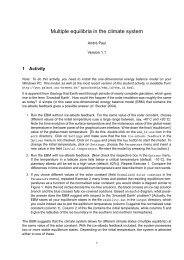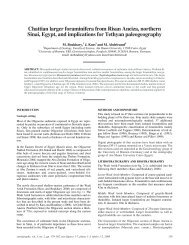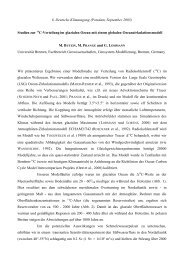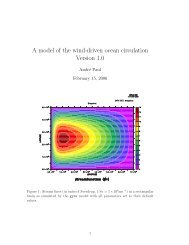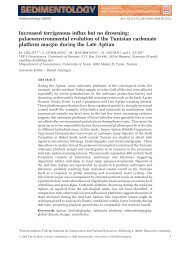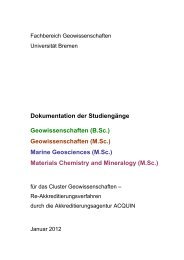Forschung im HLRN-Verbund 2011
Forschung im HLRN-Verbund 2011
Forschung im HLRN-Verbund 2011
- Keine Tags gefunden...
Erfolgreiche ePaper selbst erstellen
Machen Sie aus Ihren PDF Publikationen ein blätterbares Flipbook mit unserer einzigartigen Google optimierten e-Paper Software.
165Figure 1: Large range of energy (µ) scales in lattice QCD, where shaded areas refer to quark mass values (in theso-called MS scheme) quoted by the Particle Data Group. Red marks indicate the pion, the D- and theB-meson mass. The perturbative domain is above µ = 10GeV. It is distinct from the white region coveredby typical grids used to describe hadrons.This is a difficult problem, because it requires nonperturbativecontrol and the s<strong>im</strong>ultaneous handlingof a hadronic and a much higher energy scalewith both of them discretized finely enough. TheALPHA-collaboration is devoted to an uncompromisingsolution of this issue with innovative methods.To this end we have developed a by now wellknownrecursive finite size scaling technique.The decisive idea of that method is to considera sequence of deliberately finite sized and partiallyeven small boxes (‘femto universe’) with QCD inside.The smallest system is such that — due toHeisenberg’s uncertainty relation — it can be relatedby perturbative QCD to high energy scatteringin an infinite volume. Then successive boxesdiffer by scale factors of two only and are related toeach other by taking the continuum l<strong>im</strong>it of s<strong>im</strong>ulations.Eventually one arrives at a large box which isrelated with hadrons in lattice QCD. In this way themulti-scale problem is circumvented and a physicalscale ratio is <strong>im</strong>plemented that grows exponentiallywith the number of steps. In terms of the Figure,one starts with a high energy from the right,and then moves recursively to the left by factor tworescaling steps, until a scale suitable for hadronsis reached. This method is clearly involved, butin contrast to s<strong>im</strong>pler approaches which typicallycompromise with the multiple scales handled onsingle lattices it is more amenable to systematic<strong>im</strong>provement and error control. Its application toQCD is now far advanced [3],[2], for instance a systematic<strong>im</strong>provement of the discretization has been<strong>im</strong>plemented.In this particular project we focus on a precisiondetermination of the mass m c of the charm quarkand, in a first stage, only the lightest of the quarksare fully incorporated in the s<strong>im</strong>ulations (N f = 2).The other quarks are treated in the so-called valenceapprox<strong>im</strong>ation. A special challenge has tobe faced when s<strong>im</strong>ulating the charm quark. Itsmass around 1 GeV puts it close to the upper endof the white area in the Figure given by the ultravioletcutoff Λ UV = a −1 . Cutoff effects of orderm 2 a 2 are then relevant and have to be carefullyextrapolated away. We therefore studied latticeswith as small a discretization length as possible. Inthis effort we encountered unforeseen algorithmicproblems, which required a dedicated study. Theyare now understood to be no major hurdle on theway to precise answers [4]. We are thus ready todetermine m c in the N f = 2 theory and we willalso investigate the decay D s → l ν l . In this decaya tension has existed between the exper<strong>im</strong>entallyobserved rate and the Standard Model prediction.The latter depends on the so-called decay constantF Ds , which we will compute precisely through latticeQCD s<strong>im</strong>ulations.The result will be either another precision test ofthe Standard Model or a hint for particles or interactionsnot discovered directly as yet.More Information1. http://www-zeuthen.desy.de/alphahttps://twiki.cern.ch/twiki/bin/view/CLS2. F. Tekin, R. Sommer and U. Wolff “The Runningcoupling of QCD with four flavors,” Nucl. Phys.B840, 114-128 (2010).3. ALPHA collaboration, “Non-perturbative quarkmass renormalization in two-flavor QCD,” Nucl.Phys. B729, 117-134 (2005).4. S. Schaefer, R. Sommer and F. Virotta, “Criticalslowing down and error analysis in lattice QCDs<strong>im</strong>ulations,” Nucl. Phys. B845, 93-119 (<strong>2011</strong>).FundingDFG Collaborative Research Centre TR 09-03, EuropeanUnion project “FLAVIAnet”Physik




